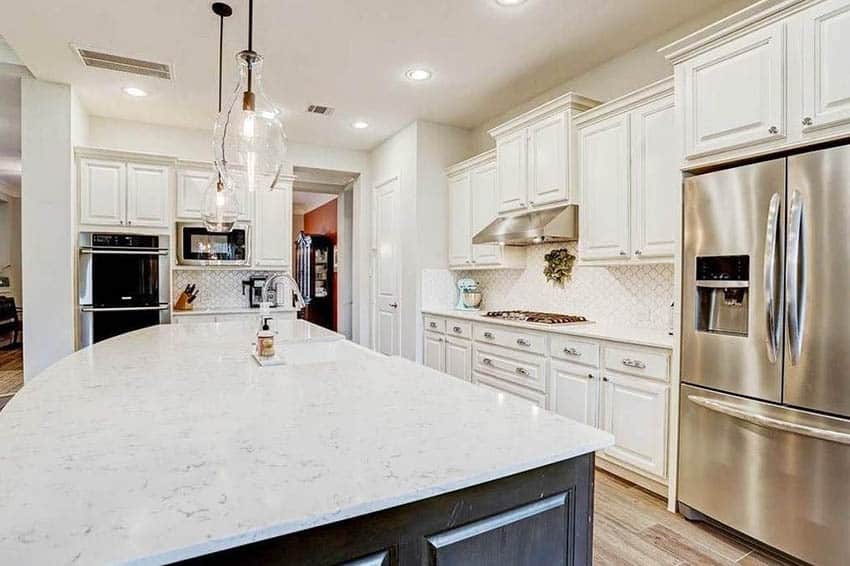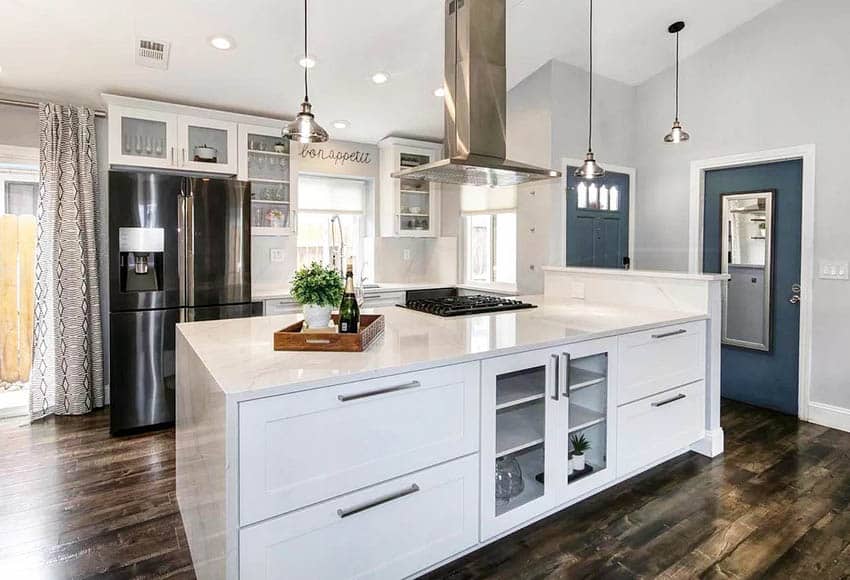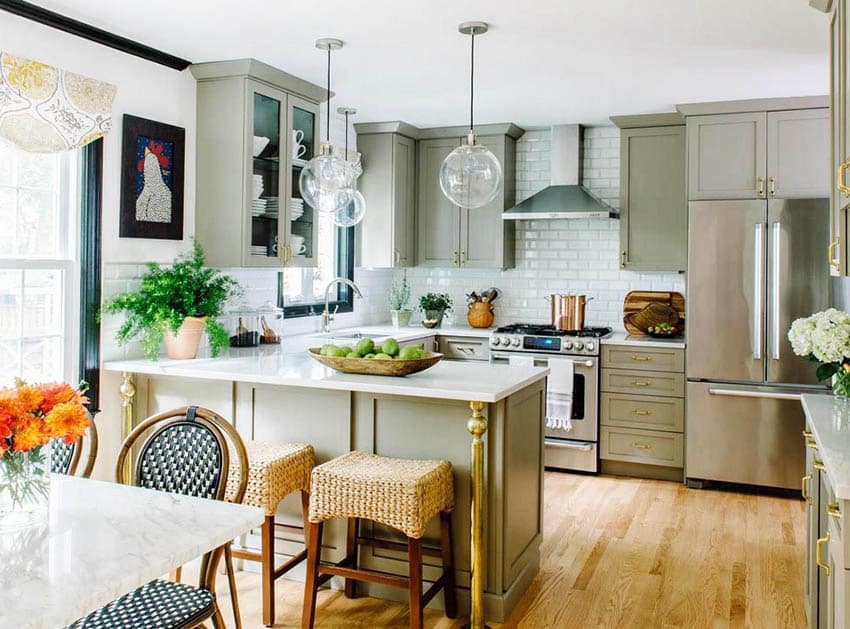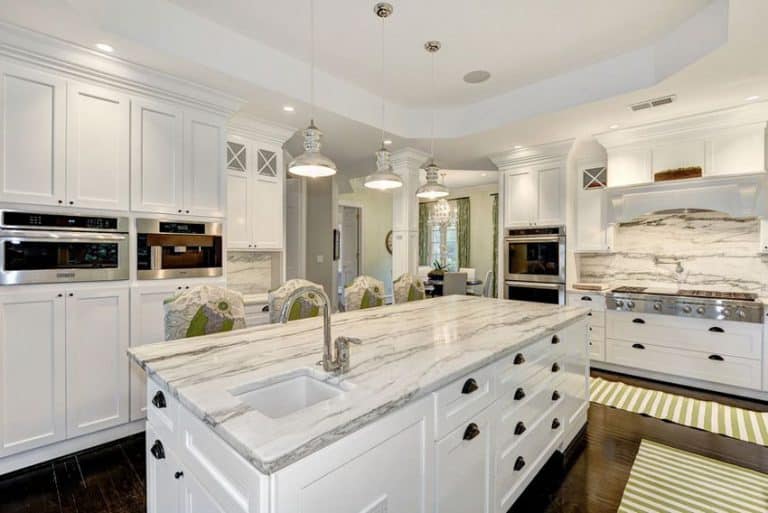Silestone Countertops (Ultimate Design Ideas Guide)
Silestone quartz countertops are extremely popular with homeowners and designers looking for a beautiful, distinctive, highly customizable and long-lasting material for their kitchen, bathroom, or workspace.

Consumers select the color, style, finish, and edge type of their countertop from a range of samples or a catalog. Since Silestone quartz is man-made, it is highly consistent from sample to installation. Unlike marble or granite, there is no need to visit a quarry to guarantee your installed product will achieve the desired effect.
Is Silestone a Type of Quartz?
Searching for the answer to this question can bring up confusing or contradictory answers. The answer is both yes and no. Silestone is a brand, created by the Spanish company Cosentino. Like Xerox or Kleenex, the name of the product has become synonymous with the product itself.
One important fact to note is that Silestone countertops from Cosentino carry a 25-year warranty, while countertops from other suppliers are subject to the policies of the business that sells them.
What Is Silestone Quartz?
Silestone is a man-made material but is composed primarily of natural ingredients. It has been around since the 90s, but has rapidly gained popularity and is now one of the most popular materials for countertops. It is highly customizable and is available in a wide range of styles. It can look very similar to marble or granite, depending on the pattern. The main component of Silestone is quartz.
Quartz is a naturally occurring mineral — one of the most common minerals on earth. It is an igneous rock, meaning that it was created through a volcanic process. When magma or lava loses heat, it cools and becomes an igneous rock. This process often includes crystallization. In the case of quartz, crystallization is the reason behind its signature sparkle.
To create these surfaces, quartz must be extracted from the earth. When a significant deposit of quartz is located, a quarry is established, and this abundant material is removed from the ground in slabs. After the slabs have been removed and cleaned, they are ground up into small particles. These particles will make up the vast majority of a Silestone countertop.
The ground quartz is mixed together with other substances (namely color agents, anti-microbial agents, and a strong polymer resin) and then poured into molds. When the mixture has been set, the surface is polished and finished according to supplier or consumer specifications.
What Can Silestone Be Used For?
Silestone is an ideal choice for a number of uses in any home, no matter what style or decor you are hoping to achieve. Due to its high durability, it is perfect for high-traffic areas like kitchen countertops or any preparation space. It is also suitable and attractive in the bathroom, as a shower tray, countertop, or backsplash.
Silestone can be used as wall cladding, to add visual interest to any space. One thing to remember if you choose this brand of quartz for your bathroom or kitchen countertop — it is not scorch-proof. Be careful with pots, pans, and hot hair styling tools.
One of the best uses for Silestone is to create a visually cohesive look in the kitchen. Kitchen sinks can actually be made from the material, creating the illusion that your work surfaces are composed of one large piece of natural material. This is a stunning design element that will add originality to your kitchen project.
Silestone is nonporous — it will not absorb liquid. It is also treated with anti-microbial agents during the manufacturing process. When taken together, these two characteristics make a strong case for its use in the kitchen where cleanliness is an absolute priority.
Unlike granite, which is porous when unsealed and requires resealing every 12 months in order to maintain it’s food safety rating, Silestone is a food-safe surface from the moment it is installed, and throughout the life of the countertop.
Is Silestone Scratch-Resistant?
Silestone quartz is one of the hardest materials you could choose for a countertop. Consumers choosing between quartz, granite, and marble will be interested to know that quartz is the hardest, most durable, and most resistant to scratches of these three popular countertop materials. This quartz rates a 7/10 on the Mohs scale of mineral hardness, similar to unglazed porcelain.
For reference, a 10/10 on the Mohs scale is reserved for a diamond, the hardest naturally occurring substance on Earth. Silestone quartz is so hard that if you were to use it as a cutting surface, you could damage your knife!
Scratch-resistant is not the same as scratch-proof. A heavy enough object dragged at just the wrong angle could possibly scratch Silestone quartz countertops. Installation professionals recommend not to drag heavy objects across these countertops.
Is Silestone Dent and Chip Resistant?
Unfortunately, no countertop is completely dent and chip-proof. Accidents happen, and a heavy object dropped from a sufficient height will damage any countertop. However, when compared to bamboo, wood, laminate, marble, or even granite, a Silestone quartz countertop is the least likely to dent or chip with normal use.
Is Silestone Stain-Resistant?
Yes! This non-porous material will not absorb color-carrying liquids. You can safely spill coffee, wine, berries, citrus, tomatoes — just about anything you can think of — and not have to worry about a stain.
Granite, on the other hand, is porous and will absorb and retain any of these staining foods unless properly sealed (and re-sealed regularly.) Since the purpose of the kitchen is to prepare food, stain-resistance is one of the most powerful points in favor of Silestone countertops over granite.
Silestone Colors
Cosentino sorts its available colors into the following categories: Grey, black, white, brown, cream, and yellow-gold. This is just the base color — veining and other pattern options are also available, as are several different finishes.
Additional colors are available through other brands, including Cambria and Caesarstone. Cambria offers more than twenty different color/design options, and Caesarstone has too many to count! All of these brands offer samples that can be sent to your home.
Silestone Slab Sizes
This material is generally sold in slabs. The standard size of Silestone quartz countertop slabs is 55 inches by 120 inches. Jumbo size is also available; it measures 63 inches by 128 inches. It can be created in thicknesses of one, two, or three centimeters.
Floor tiles (can also be attached as wall cladding to create a cohesive look or unique design element) come in five sizes: 30×30, 40×40, 60×30, 60×40, and 60×60. All floor tile measurements are in centimeters.
Silestone Quartz Countertop Pros & Cons

- It is highly customizable and comes in almost every imaginable color.
- It can mimic the look of natural stone countertops such as marble or granite.
- Unlike marble or granite, you can always replace or add to your quartz countertop and be assured of a perfect match.
- It is easy to care for and clean.
- It never needs polishing or resealing and will retain its attractive appearance effortlessly from installation throughout the life of the countertop.
- This quartz can be used in kitchens, bathrooms, mudrooms, or anywhere that requires a durable, non-porous surface.
- It can be used to construct a sink that perfectly matches your work surface.
- It’s made from one of the hardest natural materials in the world.
- It is naturally anti-microbial due to its non-porous composition. Anti-microbial agents can be added during the manufacturing process to increase resistance to bacteria and viruses, making it one of the safest materials to use in a food-preparation space.

- While this quartz is very difficult to damage, in the unlikely event that damage does occur, it cannot be easily repaired.
- In some cases, like damage due to harsh chemical cleaners, reparation is not possible, and the countertop would need to be replaced.
- Quartz is not scorch-proof.
Styles of Silestone Counters
Veined: Mineral impurities create contrasting lines of color in natural stone. These lines are called ‘veins’ and are a distinctive feature in marble and granite. Consumers wanting this appearance but without the cost and upkeep associated with natural stone will be pleased to know that this quartz variety can be created with realistic and natural-looking veins.
Marble: Not all marble has veins. It is possible to mimic the look of natural marble with Silestone quartz. Unless your social circle includes geologists, a casual visitor to your kitchen is unlikely to be able to tell the difference between quartz and marble countertops. You get all of the benefits with none of the hassle or upkeep.
Metallic: Natural quartz has an unmistakable shininess that comes from the crystalline structure of this igneous rock. Metallic flecks are a popular and common choice for homeowners who want their countertops to literally sparkle in the sunlight.
Countertop Finishes for Silestone

Polish: Polish is the best-known finish for these quartz countertops. It gleams brightly and brings a sheen to any space.
The suede texture finish is soft to the touch and has a more matte appearance. Similar to suede fabric, the texture is visible but imperceptible with the fingers. The suede or matte finish is also referred to as a honed finish.
Volcano texture is a recent innovation and has a more rugged look and feel than other finishes. The surface has a pronounced pitted look that is perfect for more industrial spaces while remaining non-porous, easy to clean, and anti-microbial.
Popular Silestone Countertop Edges
Basic Edge: the horizontal and vertical surfaces of the countertop are perpendicular to each other and meet at a right angle.
Straight Bevel: the horizontal and vertical surfaces of the countertop are perpendicular to each other, but the corner has been planed off.
Bullnose: the vertical surface of the countertop is completely rounded, forming a backward ‘C’ shape.
Demi-bull: the vertical surface of the countertop is partially rounded, forming a half-arc shape.
Ogee or Dove Chest: the horizontal surface of the countertop ends in a concave arch before transitioning into a convex arch.
Silestone Cost
How much do Silestone quartz countertops cost? An important factor for any consumer choosing countertops is the price. Quartz is a highly durable, beautiful, and long-lasting material, and it has a price tag to match these qualities.
You should expect quartz countertops made from this material to cost between $50-100 per square foot. While it is sometimes possible to get granite countertops for a lower price, the price of yearly polishing and/or resealing is not included. You may find that when maintenance and upkeep are calculated over the life of the countertops, this variety of quartz is the most affordable choice.
If you’ve decided on these countertops but are looking for ways to keep the cost as low as possible, consider asking your contractor or supplier if there are remnants available. Remnants are pieces of countertop that were created for a job that was abandoned for some reason — perhaps the consumer changed their mind, or the project went in a different direction.
Another thing to consider when it comes to the cost of these quartz countertops is customization. This quartz is highly customizable, coming in almost every imaginable color and finish. As with any bespoke product, the more customizations you want, the higher the price will be, so stick to default configurations for the most affordable price.
Silestone vs Quartz
Silestone is made of ground-up quartz. It is technically a brand name for quartz countertops, but the terms are often used interchangeably.
Difference Between Cambria and Silestone
Cambria is yet another brand name for quartz. Different colors may be available. The Cambria quartz countertops are produced in the USA.
How Does Silestone Differ from Granite?

This material replicates everything great about granite with none of the drawbacks. Granite needs to be resealed annually and treated regularly with isopropyl alcohol, while Silestone requires no maintenance beyond routine cleaning and never needs to be resealed.
It has the look and feel of granite, but is more durable. Neither granite nor Silestone is scorch-resistant. Depending on customization and availability, the latter may be more expensive than granite, but this cost difference can be all but eliminated when maintenance is calculated. You can find out more about quartz vs granite here.
Marble vs Silestone
While marble can sometimes be obtained at lower prices than Silestone quartz, there are several important drawbacks to consider. Because marble is completely natural, it is only possible to match it with other marble quarried from the same deposit at around the same time. If you ever intend to repair, replace, or add to your countertop, it is advised to use this material for ease of matching.
It is more durable than marble and can convincingly replicate marble’s signature veined style. The quartz is non-porous and stain-resistant, while marble is porous and liable to stain, Also, because quartz is abundant, it can usually be obtained much closer to your construction site than marble, making it a more eco-conscious choice.
What Makes Silestone Different from Caesarstone?
Caesarstone is another brand name for quartz countertops. While Silestone is at least 90% quartz, Caesarstone is at least 93% quartz. This does not affect performance.
Silestone Problems
No material is perfect. It is very dense and heavy, so it is important to check that your cabinets can support it. It is not intended for use outdoors. Finally, it is possible for the resins used in the materials to fade if exposed regularly to direct, harsh sunlight.
How to Clean Silestone
This material is simple to clean. All you need is a mild, non-abrasive cleanser, water, and a soft cloth. Because it is non-porous, the surface will not absorb liquid, but it’s still best to wipe up any spills right away. If you accidentally use an abrasive or harsh cleaner like ammonia or bleach, use water to neutralize it as soon as possible, as this can permanently damage the countertop.
Silestone Maintenance
These countertops are easy to care for and maintain. Unlike granite, it does not ever need to be resealed. Simply treat it kindly. Don’t place scorching hot pans directly on it, too.
Avoid dropping or dragging anything heavy across the surface, and don’t cut or chop anything directly on the surface. Clean it regularly with a mild cleanser and water, and it will maintain its brilliant appearance for decades. Nothing could be simpler.
DO NOT use harsh chemical cleaners! They are not necessary and could result in cloudy white blotches wherever the cleaning chemical reacts to the resin in your countertop. These cloudy white blotches, resulting from improper cleaning, are permanent and so should be avoided at all costs.
There is a small chance that your tap water is acidic enough to damage the resin in your quartz countertop. This is more likely if your water is delivered through a central city system rather than a well. Before making your final countertop selection, it is a good idea to test the acidity of your water.
Are Silestone Surfaces Safe?
Some consumers may be concerned about the safety of quartz countertops after hearing that granite countertops can leach radon into the air. Rest assured, quartz countertops are non-radon-emitting and completely safe to install in your home.
For more information, you can ask your supplier to see the MSDS or material safety data sheet. Any reputable supplier will be able to produce this quickly and easily.
Consumers concerned with the health and safety of the workers who produce such quartz countertops should check to make sure they are sourcing materials from a reputable and ethical supplier.
There is no danger to the homeowner of inhaling small particles of quartz, as the countertop is completely sealed before it arrives to be installed. Any reputable manufacturer will be able to demonstrate that they take adequate measures to protect their employees from silicosis (a disease caused by inhaling silica dust.)
To see more beautiful designs, visit our gallery of Calacatta quartz countertops.


























I’m considering buying the Silestone Pietra counters for my kitchen because my wife and I like how they look online, but when we went to see them in person they looked different. We’re going to try another store to see if there is much variation.